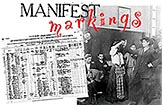

|
Markings on the Manifest's Occupation Column |
|
The most obvious markings in the occupation column relate directly to an occupation, and either correct or clarify the immigrant's trade. But the most perplexing annotations in that column have nothing to do with any occupation. Rather, they are number, letter, and date codes relating to later naturalization activity. They can be recognized by their being written--or the annotation beginning--in the occupation column, and by their adherence to a common format or style. |
|
Numbers, Dates, Cryptic letters and words . . . |
1.  |
|||||||||||||||||||||||||||||||||||||
|
In 1926, the occupation column was set aside for annotations relating to the verification
of immigration records for naturalization purposes. Since 1906, no immigrant who arrived
after June 29, 1906, could naturalize until the government located their immigration record.
Thus since 1906, after an immigrant filed a Declaration of Intention or a Petition for
Naturalization in a naturalization court, the Bureau of Naturalization was called upon to
provide a certification of the immigrant's arrival record. The certification, called a
"Certificate of Arrival," was sent to the courthouse to satisfy the naturalization requirement
that everyone who arrived since June 29, 1906 had to have a legal immigration record if they
wanted to become a U.S. citizen.
From 1906 to 1926 this activity took place without any notation made on the passenger list being certified. But in 1926 verification clerks began to record the verification (record check) and certification activity on each passenger list record. This change came about in response to a terrible scandal about fraudulent naturalizations. By noting that a given immigration record had been used to support an individual naturalization, the annotation served in future to prevent anyone else from using that record for another naturalization. While the annotations may be found on any passenger list, before or after 1926, they will all relate to naturalization activity occurring in 1926 or later (see below). Remember also that the passenger lists were microfilmed in 1942/43, so records of immigrants who arrived earlier but did not begin the naturalization process until after 1942 could not be annotated. | ||||||||||||||||||||||||||||||||||||||
|
All the verification for naturalization annotations follow a prescribed format containing one or more of the following elements: District number where the application was filed, application number, date of verification, and document issued. The table below identifies each element for the examples illustrating this page. Note that not all annotations of this type will contain every element. Examples 2, 4, and 5 do not indicate what document was issued, and examples 3 and 5 contain no date.
Example 5 suggests two family members who immigrated together also later applied for naturalization together. They applied in the same District (#18), and their application numbers are almost consecutive. Example 6, below, shows a record with two dates annotated: One for the original verification in 1935, and another from a "Recheck" in 1937.
|
2. | |||||||||||||||||||||||||||||||||||||
|
3. | ||||||||||||||||||||||||||||||||||||||
|
4. | ||||||||||||||||||||||||||||||||||||||
|
5. | ||||||||||||||||||||||||||||||||||||||
6. 
| ||||||||||||||||||||||||||||||||||||||
| At times, Verification Clerks could not be sure the record found really did relate to the person who claimed that arrival record on their naturalization application. If there were enough significant differences, the clerk could not certify the arrival record. Minor differences were routine--ages one or two years off, hight off by a few inches, or Americanized names (Jacob for Yankel, for example). But many years difference in age/date of birth, differing eye color, or place of birth, prohibited certification without further explanation. In those cases, the clerk issued a record (Form 505, or 404), but issued no Certificate of Arrival. Hence the frequent annotation "No C/A." | ||||||||||||||||||||||||||||||||||||||
|
Verification of Arrivals prior to June 30, 1906. As noted above, there was no Certificate of Arrival requirement for immigrants who arrived prior to June 30, 1906. Nevertheless, one will see occational naturalization verification activity associated with pre-1906 lists. The example below is from a 1903 passenger list, and displays two characteristics of verifications for pre-1906 arrivals. One is the "X" between the district number and the application number. The "X" means the applicant did not have to pay the Certificate of Arrival fee, and in this case was exempt because he arrived before 1906. The other is the reference to issuance of a "C.L ." (or C/L), which is a Certificate of Landing. A Certificate of Landing served the same purpose as a Certificate of Arrival in the naturalization process, but since the latter were only issued to those who arrived after 1906, they needed another name for certifications from pre-1906 records.
 | ||||||||||
| Interpreting the Verification for Naturalization Annotations . . . | ||||||||||
|
This step is not so simple as it may seem. The presence of a verification annotation in
the occupation column indicates the immigrant initiated naturalization activity between
1926 and 1942/43. In cases where no date is shown, there is no way to determine when this
activity occurred. The application number is useless in finding naturalization records.
Only the District key number is of limited help, in that one can usually use the number to
determine a general location where the immigrant was living when he/she filed their
application.
Unfortunately, the Naturalization Service would occasionally re-number all the districts. This means that Chicago might be in District #6 in 1927, but in District #11 in 1931. Chicago did not become District #9 until the early 1940's. Thus it is extremely important to know the date of the annotation if one is to convert the District number into a geographic region of the country. The tables below show the Districts by number during different time periods. If you don't have a date, or if your date may fall on either side of a dividing line, check both or all tables for the locations. Some knowledge of the immigrant's history should allow you to guess which table fits your annotation.
| ||||||||||